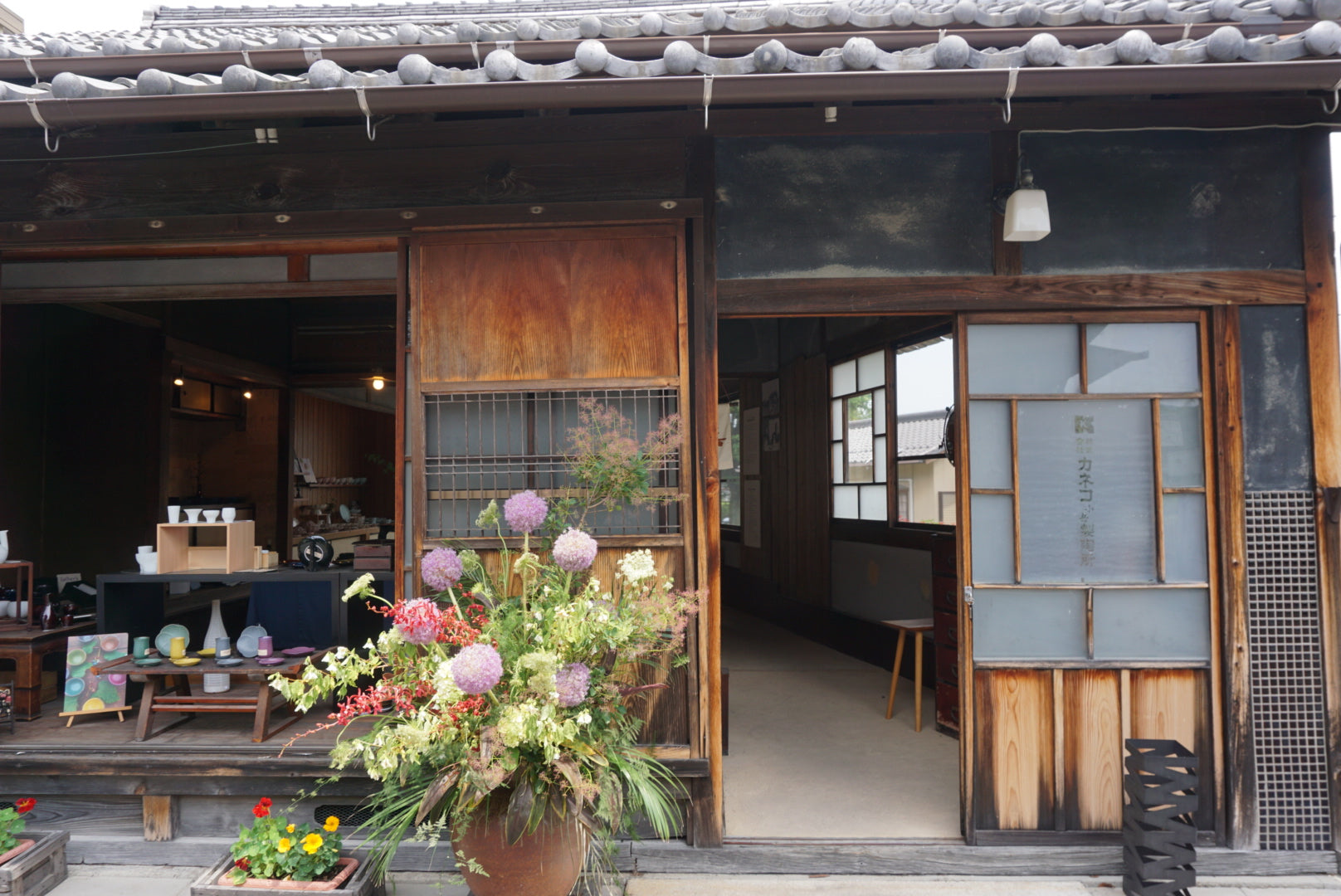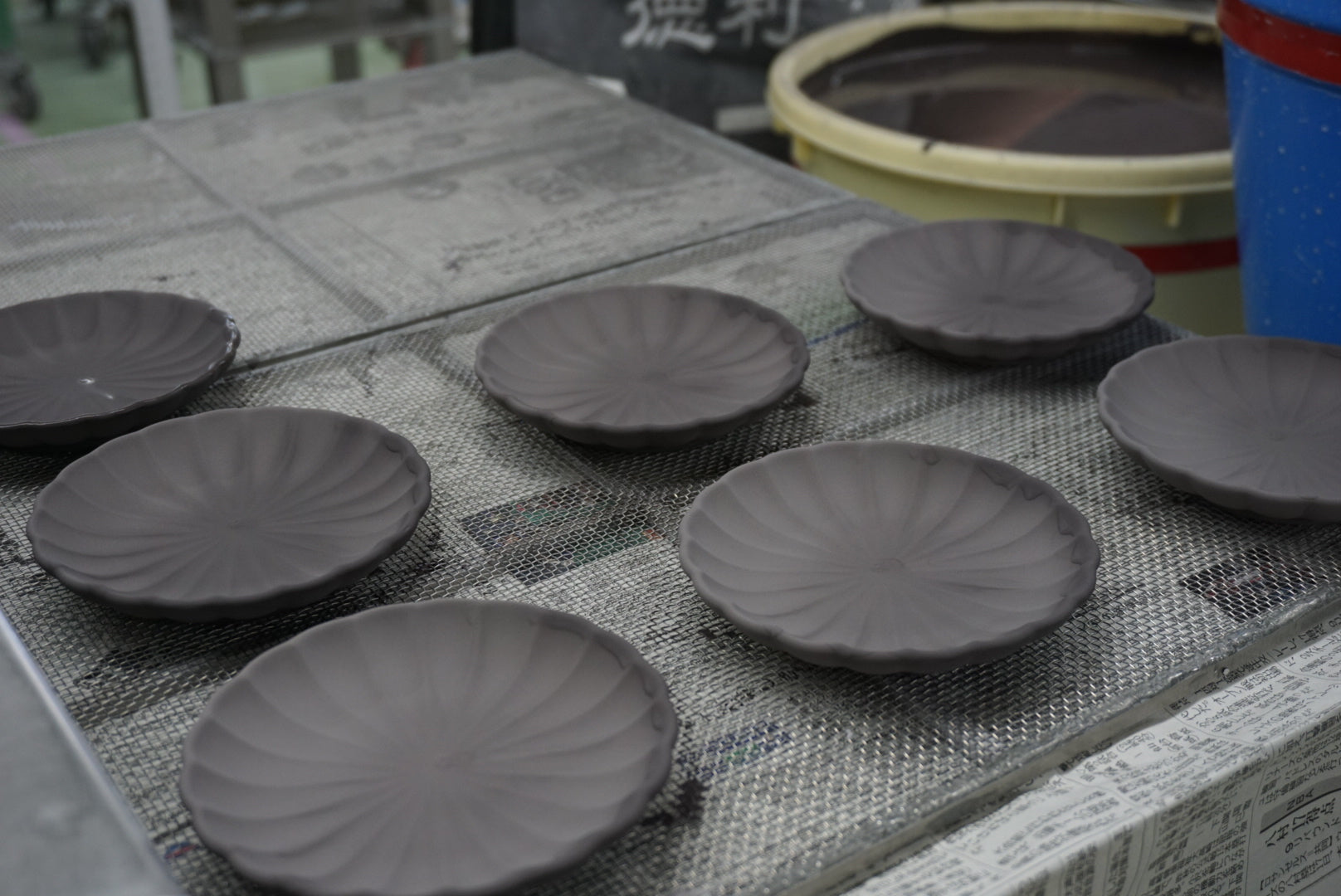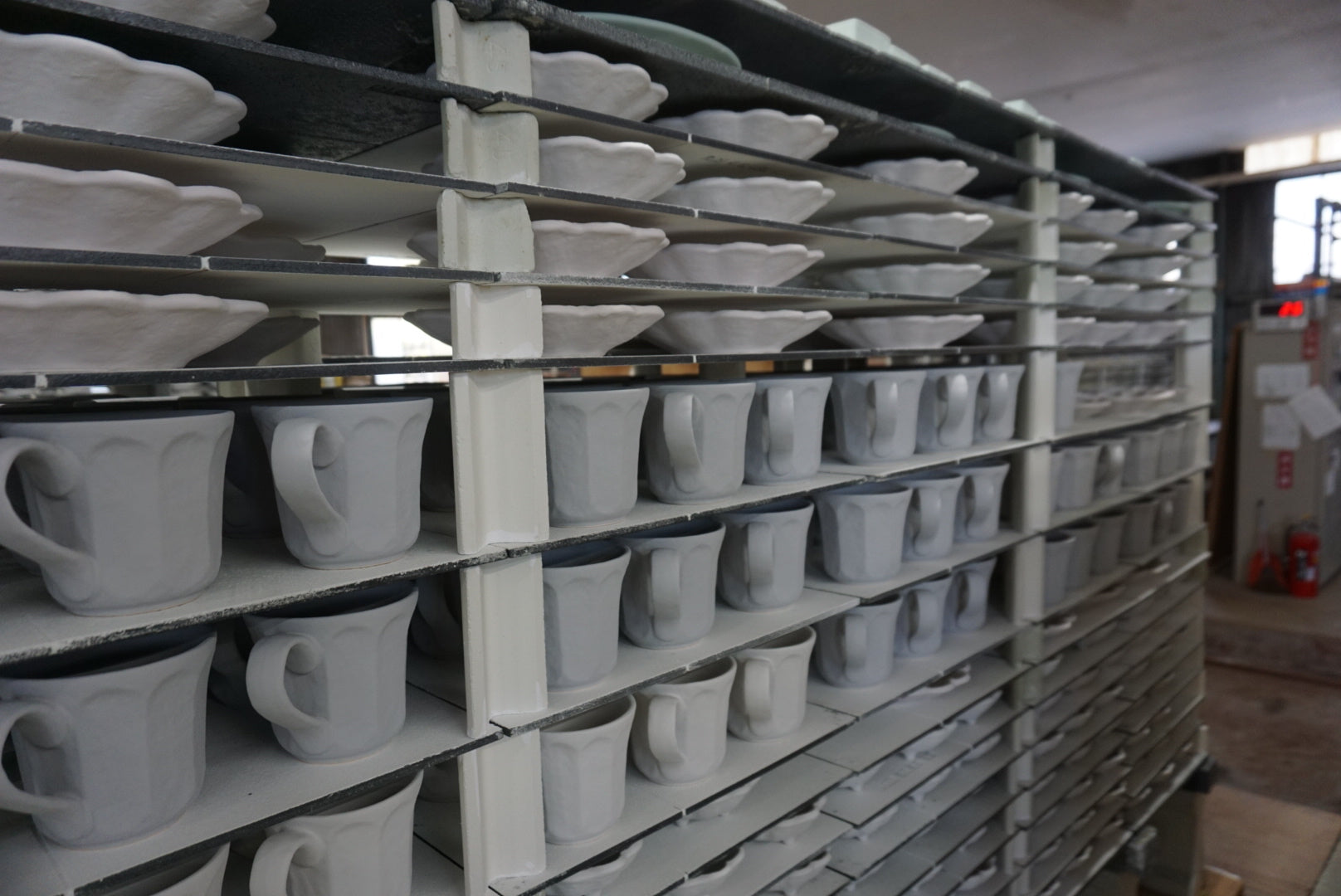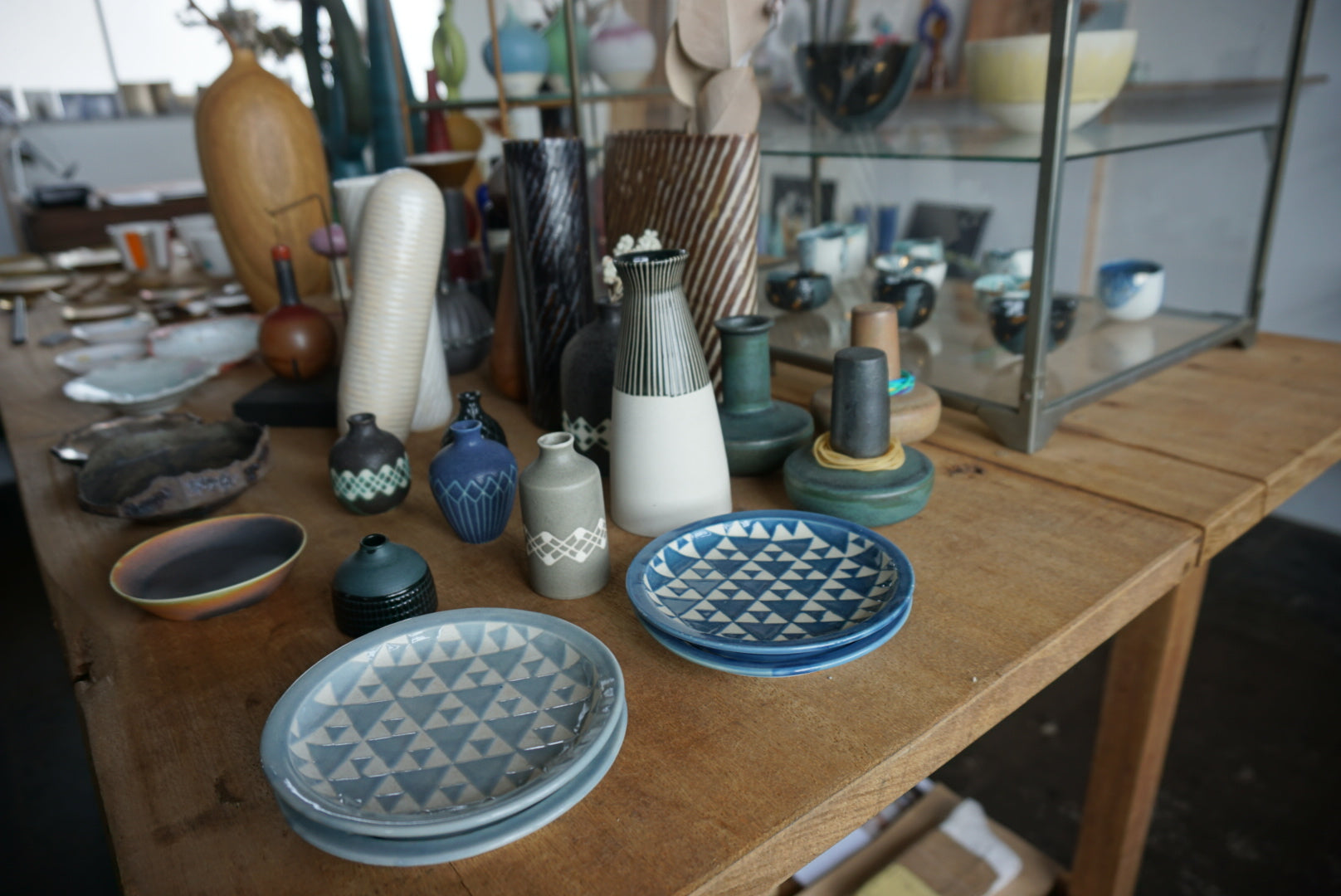This time we will go to Toki City and Tajimi City in Gifu Prefecture, which are known as Mino ware towns.
We
visited Kaneko Kohei Pottery, which boasts a 100-year tradition.
Mino ware boasts a history and tradition of 1,300 years.
Blessed with high-quality fuel and raw materials, more
than 50% of Japan's ceramic production is made in the surrounding area.
In particular, the cities of Toki and Tajimi in Gifu Prefecture that I visited this time are towns with a calm
atmosphere and are home to many pottery factories.
We met Mr. and Mrs. Ito of Kaneko Kohei Pottery, who have
been involved in manufacturing for over 100 years in Toki City, where time passes slowly, and we enjoyed seeing and
experiencing the charm of Mino ware.
Start your day with a tour of pottery and cafes!
The theme of the day is "Enjoy seeing and touching the utensils and visiting cafes."
I want to have a wonderful experience that will bring a smile to my face, so I start by thinking about the flow of the day again on the train.
Arrival at Toki City Station
Start your trip from Toki City Station!
It took about an hour to walk to Kaneko Kohei Pottery, but I walked slowly, feeling the nature.
The river flows
through the center of the town, creating a calm and relaxing atmosphere.
It was a sunny day when I visited!
It is a scenery where the blue sky and the deep greenery of the mountains
stand out even more.

During the walk, I first looked for breakfast to fill my stomach.
Let's go to Cafe Magokoro Komite, a rice flour bread specialty store that is popular among locals.
I received
the luxurious morning set and was very satisfied from the morning.

As it uses rice flour, the inside is chewy.
In particular, the chewy texture and sweet taste of the rice wassan
was exquisite.
Finally, let's go to Kaneko Kohei Pottery!
Once we are full, we will head to Kaneko Kohei Pottery.
I saw a pottery factory at the end of a narrow alley.
The pottery and gallery are adjacent.

This time we spoke to Mr. and Mrs. Katsunori Ito and Hisako, the third generation company president.
We produce brands such as "Giyaman Tou" and "Linka" with the idea of "creating tableware that can be used in everyday life."

We spoke with Kaneko Kohei Pottery, which celebrates its 100th anniversary this year and continues to take on new challenges and create pottery while valuing tradition.
Let's start with a tour of the utensils.
There is a gallery space next to the pottery factory.
Therefore, we also hold sales for general customers on the
first Saturday of every month.

The old folk house is decorated with flowers and has a quaint atmosphere.

This is "linker".
The simple design is attractive so that the food you serve stands out.
The warmth and handmade feel comes
through in each piece of pottery.
It is carried by Roman&William Guild, a New York interior shop famous in the interior design world, and is even
used in the tableware served at the attached cafe.
The design, which looks like a flower blooming, will capture
your heart.

Kuroren gives the impression of adding a sense of solidity to its simplicity.
It is also attractive that the
atmosphere can be completely changed with just one color.

It seems that cool blue is popular in summer.

This is Giyaman pottery.
The colors look even deeper when you see them in real life, and you'll fall in love
with them in an instant!

The color changes depending on the angle and brightness, so you won't get tired of looking at it for a long time.
It's as transparent as glass.

And there's also an interesting bowl called a calorie bowl.
At first, when Giyaman pottery was not selling well,
"How can we make people feel familiar?"
"How can we get
people to pick it up right away?"
If it's just a bowl, it's interesting.
He came up with this bowl because he
wanted to create a health-conscious style because he didn't have any.
The playful idea makes you feel more familiar with pottery.
They seem to value the attitude of incorporating a
little innovation and new things into tradition.
Next, we visited the pottery.

As the molding is outsourced, the pieces are first sent to a bisque kiln.

Then, the "unglazed" items are listed in order, sorted by ordering company.

Press the back stamp of "Kohei" and proceed to the glazing process.

We observed the process of the staff applying the glaze.
The way the glaze is applied carefully one by one is
truly a work of craftsmanship.
In the manufacturing process of Giyaman pottery, the glaze is first applied all over to prevent thinning of the edges or uneven coloring.

On the other hand, when it comes to linkers, the fading of the colors gives it a handmade feel.
You can feel the
meticulous attention to detail.
The glaze is mixed and combined differently depending on the type and color of the pottery.
Most of the glazes are natural materials.
The blending of raw materials is a true professional skill, as they
vary exquisitely depending on the natural environment.

We are built on a relationship of trust with a glaze company that knows the perfect blend of glazes to match each
pottery.
The tradition of Mino ware has been passed down through the exquisite overlapping of each process,
including the preparation of the glaze, the mountain and soil conditions from which the material is harvested,
temperature settings, how to apply the glaze, and the state in which it is fired. I realized that.

This is the process of Giyaman pottery.
The glaze is applied one after another by the hands of veteran staff
with decades of experience in this field.
Actually, 98 out of 100 pieces of Hagiyaman pottery were initially defective.
Depending on the season, the
condition of the kiln, and the temperature, even now, when checking the finished firing, there are some items that
cannot be sold because they say, "This color is different..."

I felt their commitment to manufacturing through their uncompromising attitude of "only delivering what we are truly confident in."

After glazing, it is fired in a kiln at 1300 degrees. This is before baking.

Put them into the kiln in order.

We will put it in a large kiln and bake it slowly.
Even after firing, the temperature of the kiln exceeds 200
degrees.
When the door is opened, the hot air reaches the staff working there, making it a battle against the
heat in the summer.

While inheriting the tradition of Mino ware, Ms. Ito says with a smile that she never forgets to try new things.
Due to the feelings of Mr. Yuki, the son of Mr. and Mrs. Ito and the 4th generation, they have begun to proactively
disseminate events such as holding events held at the gallery on Instagram Live.
He has also started posting
information about utensils on YouTube.

"However, the best way is to see the pottery in person and have them like it.
I'm happy when the customer says, "I'm
finally here," or "I came to see the pottery." says Ito.
It seems that the staff members are motivated by the fact that people who love pottery come out of their way to pick up the items they have made and receive compliments from them.
Listening to the friendly Mr. Ito's stories, learning about his commitment to manufacturing, and experiencing actual pottery, I myself became a fan of Kaneko Kobei's pottery more than anything else.
It was a moment when the strong feelings contained in the simple words of "better things, more familiar things" were conveyed through each pottery.
Move to Tajimi and take a break at "Café Wani"
After leaving Toki City, I took the train one stop to Tajimi City.

Take a break at Cafe Wani, which is about a 5-minute walk from the station.
The building, which was originally a watch shop, has been renovated and now houses a bookstore, coffee shop, and
rental rooms.
The store was decorated with lots of pottery, and you could even take books from the bookstore to
the cafe to read.

It was a hot day with temperatures exceeding 30 degrees, so I ordered an iced coffee.
Read the free paper you
got at the tourist information center at the station.
There are many booklets with wonderful designs that make it
exciting to go out.

Examine the pottery at “Honmachi Oribe Street” lined with old folk houses!
After relaxing at the cafe, head to Honmachi Oribe Street, which is lined with pottery shops and antique shops.
It is a relaxing street lined with retro buildings.

When visiting pottery shops, I discovered that each shop had different types and flavors of pottery.
You can see
that the people at each store are very particular about their selection.

Also, there was a building called "Shinmachi Building" a little away from Honmachi Oribe Street.
This is a
50-year-old vacant building that has been renovated and is a space where galleries and events related to ceramics are
held, with the concept of "creating a place for interaction between ceramics and the local community."
On the second floor, there is a selection of vessels selected by the owner, mainly Mino ware, from young artists to vessels with unusual designs.
On the 4th floor, there is a shop with a wide selection of ceramics, miscellaneous goods, clothes, etc. selected from all over the country.

Although it has a unique atmosphere, we have a collection of unique artists who put their thoughts into each piece.

From stylish designs to simple colors, there is a gallery of ceramics that you will never get tired of looking at.
It was a space that made me curious and excited.

Finally, look back on your trip with “GOOD DAYS COFFEE”
Replenish your sweet tooth at GOOD DAYS COFFEE, located about a 15-minute walk from Tajimi Station.
The stylish
atmosphere makes it easy to enter even on your own, so you can stop by on your way to sightseeing.

You can choose from two types of flavorful coffee made with high-quality coffee beans: dark roast and medium roast.
Choose dark roast coffee and baked cheesecake.

Reflect on your day while enjoying the combination of the strong depth of coffee and the moderately sweetness of cheesecake.
At "Kaneko Kohei Pottery", you can feel the commitment to manufacturing, experience a lot of Mino ware, and
experience delicious food.
It was a day where I could truly experience "touch, see, and enjoy".
You can view the utensils introduced this time here.
May you enjoy your daily meals with your favorite utensils.